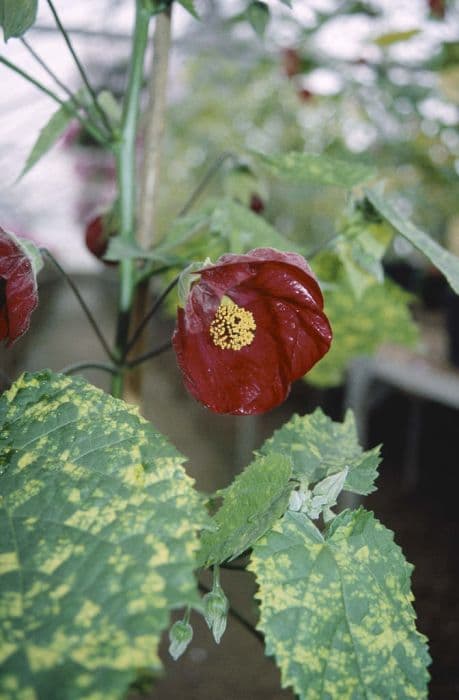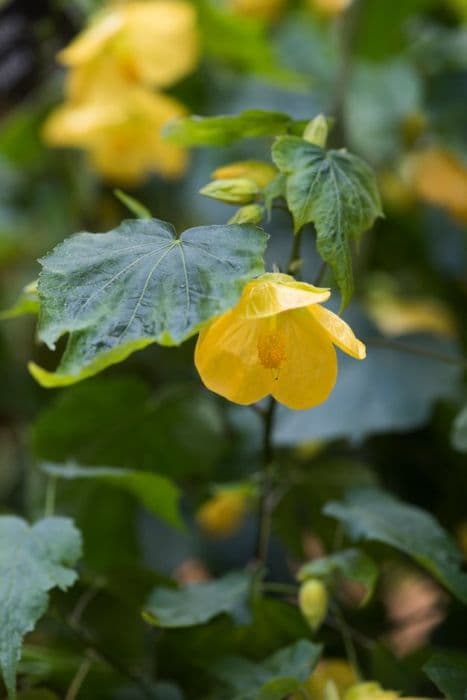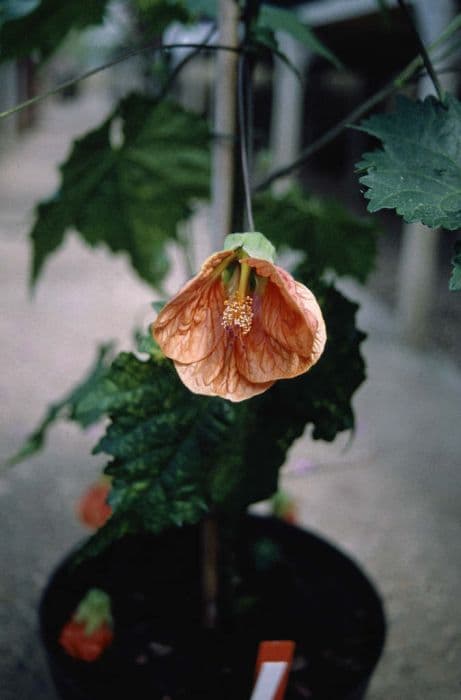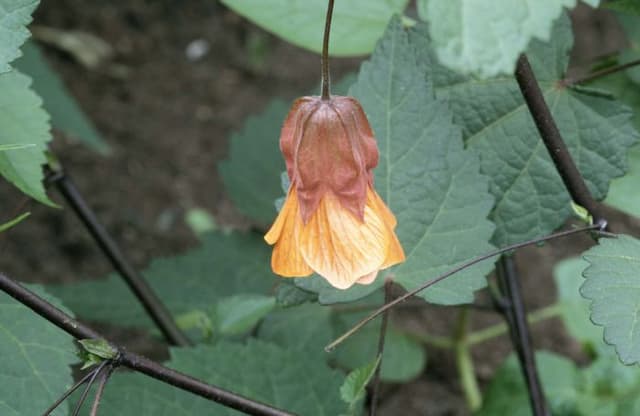Small-leaved Lime Tilia cordata 'Winter Orange'

ABOUT
The 'Winter Orange' is a cultivar renowned for its striking ornamental features throughout the year, especially during the winter season. During this time, the branches and twigs exhibit a remarkable orange-brown color which lends the plant its name, offering a vibrant splash of color in the typically drab winter landscape. The plant's leaves are heart-shaped and boast a rich green color during the growing season. They provide a dense canopy that can create a lush and inviting atmosphere. The foliage often turns to an eye-catching yellow in the fall, adding to the plant's seasonal appeal. In the summer, the plant produces small, fragrant flowers that are cream-colored, attracting pollinators like bees. These flowers are arranged in clusters that dangle from the branches, giving it a soft and somewhat whimsical appearance. As the season progresses, the flowers give way to small, nut-like fruits that are a favorite among birds and wildlife, making the 'Winter Orange' a beneficial addition to any garden for promoting biodiversity. The bark of the 'Winter Orange' is generally gray, providing a subtle yet pleasing contrast with the bolder colors of the branches in winter. The combination of its year-round aesthetic appeal with its wildlife-friendly characteristics makes the 'Winter Orange' a popular choice for gardeners and landscape designers looking to add both beauty and ecological value to their spaces.
About this plant
 Names
NamesFamily
Malvaceae
Synonyms
Winter Orange Linden, Winter Orange Lime, Winter Orange Small-Leaved Linden
Common names
Tilia cordata 'Winter Orange'.
 Toxicity
ToxicityTo humans
The Small-leaved Lime, or Tilia cordata 'Winter Orange', is generally not known to be toxic to humans. It doesn't contain any known toxic substances that would cause poisoning when touched or ingested. Therefore, there are typically no symptoms associated with poisoning from this plant, because it is not considered poisonous.
To pets
The Small-leaved Lime, or Tilia cordata 'Winter Orange', is also not known to be toxic to pets. It does not contain substances that are harmful to animals, so ingestion of the leaves or flowers typically does not lead to poisoning. Consequently, there are no specific symptoms of poisoning or consequences from pets ingesting any part of this plant.
 Characteristics
CharacteristicsLife cycle
Perennials
Foliage type
Deciduous
Color of leaves
Green
Flower color
Yellow
Height
50 feet (15 meters)
Spread
35 feet (10.6 meters)
Plant type
Tree
Hardiness zones
3
Native area
Europe
Benefits
 General Benefits
General Benefits- Attractive Year-Round Appearance: Tilia cordata 'Winter Orange' boasts heart-shaped leaves and a dense canopy, providing lush greenery during the growing season and a structural interest during winter months.
- Wildlife Habitat: The small, fragrant flowers are a nectar source for bees and other pollinators, while the tree itself provides shelter for various bird species.
- Shade Provision: With its broad canopy, the tree offers ample shade, making it ideal for parks, gardens, and streetscapes to help reduce summer temperatures and provide a cool area for leisure activities.
- Ornamental Bark: The 'Winter Orange' cultivar features striking orange-red young twigs and stems, adding winter interest to landscapes when many plants are dormant.
- Urban Tolerant: This cultivar exhibits a good tolerance to urban pollution and soil compaction, making it suitable for city environments.
- Low Maintenance: Once established, it requires minimal care, making it a good option for both public spaces and home gardens with limited maintenance resources.
- Drought Resistance: After becoming established, the tree shows a degree of drought resistance, enabling it to survive in varying climatic conditions with less need for irrigation.
- Erosion Control: The strong root system of Tilia cordata helps stabilize soil, making it useful for planting on slopes or areas prone to erosion.
- Moderate Growth Rate: The tree grows at a moderate rate, which is ideal for landscaping as it achieves its mature form relatively quickly without being overly aggressive.
 Medical Properties
Medical Properties- Expectorant: Small-leaved lime, the species Tilia cordata, is traditionally used to help clear mucus and phlegm from the respiratory system.
- Diaphoretic: The flowers of the plant are used to induce sweating, which is a common practice in herbal medicine to help reduce fevers.
- Sedative: Lime flower tea is commonly used in European folk medicine for its sedative effects to alleviate symptoms of anxiety and promote relaxation.
- Antispasmodic: It is used to alleviate minor muscle spasms, possibly helping in conditions like gastrointestinal discomfort.
- Anti-inflammatory: The flowers may offer anti-inflammatory properties, which could help with swelling and pain in inflammatory conditions.
 Air-purifying Qualities
Air-purifying QualitiesThis plant is not specifically known for air purifying qualities.
 Other Uses
Other Uses- The wood of the Small-leaved Lime is often used by carvers and turners due to its fine grain and ease of working, making it suitable for intricate woodworking projects, like musical instrument making.
- In landscaping, the Small-leaved Lime is prized for its attractive winter twig color, providing seasonal interest in winter gardens and landscapes.
- The inner bark, or bast, has traditionally been used to make ropes and mats because of its strong fibrous qualities.
- Small-leaved Lime can be planted as a part of a hedge, thus its pruning trimmings might be used for creating woven wattle fences for garden borders or raised bed supports.
- The nectar-rich flowers are a favourite of bees, with beekeepers sometimes planting Small-leaved Lime trees to increase honey production.
- In some cultures, the dried leaves have been added to herbal tea blends for their subtle flavor, not necessarily for medicinal purposes.
- Its sap can be tapped and used as an ingredient in syrups or fermented to make a mildly alcoholic beverage similar to the way birch sap is used.
- Lime trees are sometimes used in forest schools or outdoor classrooms in Europe, providing shelter and a calming environment conducive to outdoor learning.
- The tree's dense foliage can serve as a natural sound barrier, making it useful in urban and suburban environments where noise pollution is a concern.
- The Small-leaved Lime's blossoms can be used in the crafting of natural dyes, offering hues that can be used in textile and artisanal crafts.
Interesting Facts
 Feng Shui
Feng ShuiThe Small-leaved Lime is not used in Feng Shui practice.
 Zodiac Sign Compitability
Zodiac Sign CompitabilityThe Small-leaved Lime is not used in astrology practice.
 Plant Symbolism
Plant Symbolism- Loveliness: Tilia cordata, commonly known as the small-leaved lime or small-leaved linden, is often associated with loveliness due to its delicate heart-shaped leaves and fragrant flowers.
- Peace: The linden tree has traditionally been a symbol of peace and is often found in community spaces and central squares in Europe, representing communal harmony and justice.
- Fidelity: In folklore, the linden is sometimes seen as a symbol of fidelity and love, partly because of its frequent use in marriage ceremonies and folklore.
- Friendship: The linden tree has also been a symbol of friendship, perhaps due to its long lifespan and the shade it provides, which has historically been a gathering place for socializing.
- Healing: With historical use in traditional medicine, parts of the linden tree have been used to relieve various ailments, contributing to its symbolism as a healing and nurturing entity.
 Water
WaterFor the Littleleaf Linden, water needs might vary depending on soil and climate conditions, but a general guideline is to water young trees once a week with about 15 to 25 gallons of water, ensuring you're moistening the soil deeply. As trees mature, they are more drought-tolerant, but during extended periods of dryness, it's still important to provide deep, infrequent watering, possibly reducing to every two weeks. Adjust watering frequency based on weather conditions, with less water needed during rainy seasons and more during droughts.
 Light
LightThe Littleleaf Linden thrives best in full sun to partial shade, so a spot that provides at least 4 to 6 hours of direct sunlight and dappled shade for the remainder of the day is ideal. Avoid placing it in deep shade since it could hinder its growth and bloom potential.
 Temperature
TemperatureLittleleaf Lindens are hardy and can withstand a wide range of temperatures, typically from -30 to 100 degrees Fahrenheit. Ideal growing conditions for this plant are within the 50 to 75 Fahrenheit range. It's essential to avoid temperature extremes, particularly the intense cold that might damage young saplings.
 Pruning
PruningPrune the Littleleaf Linden to maintain its shape and health, removing any dead or crossed branches during the dormant season, ideally in late winter before the spring growth starts. It's not necessary to prune every year, but periodic inspection and removal of problematic branches can prevent future issues and stimulate new growth.
 Cleaning
CleaningAs needed
 Soil
SoilSmall-leaved lime 'Winter Orange' thrives in well-draining, fertile loam with plenty of organic matter. The ideal soil pH ranges from 6.0 to 7.5. A mix of two parts loam, one part peat or compost, and one part sharp sand or perlite would be suitable to facilitate drainage and aeration.
 Repotting
Repotting'Winter Orange' small-leaved lime trees are typically outdoor plants and do not require frequent repotting. Young trees may need repotting every 2-3 years to encourage growth, but mature trees are usually planted in the ground.
 Humidity & Misting
Humidity & MistingSmall-leaved lime 'Winter Orange' prefers moderate to high humidity levels but is adaptable to different outdoor conditions. Ensuring it is planted in an open area with good air circulation will help replicate its natural habitat.
 Suitable locations
Suitable locationsIndoor
Place 'Winter Orange' small-leaved lime in bright light and cool temps.
Outdoor
Plant in well-drained soil, full sun to partial shade, and shelter from winds.
Hardiness zone
3-7 USDA
 Life cycle
Life cycleThe Winter Orange Linden (Tilia cordata 'Winter Orange') begins its life cycle as a seed, which germinates in spring when soil temperatures are suitable. After germination, the seedling emerges and begins to establish its root system and grow its first leaves. As the plant progresses to the sapling stage, it develops a woody stem and a more extensive root structure, with the distinctive heart-shaped leaves of the linden becoming more prominent. Over the years, the sapling matures into a full-sized tree, characterized by a sturdy trunk, branching patterns, and a canopy of leaves; flowers typically begin to appear in early summer, small and fragrant, attracting pollinators. The tree reaches its reproductive maturity and continues to bloom annually, with its seeds dispersed by wind or animals. In its mature stage, the Winter Orange Linden can live for several decades, continuing the cycle by producing seeds each year, which will lead to the next generation of linden trees.
 Propogation
PropogationPropogation time
Late Winter-Early Spring
Tilia cordata 'Winter Orange', commonly known as the small-leaved lime with a distinctive winter stem color, can be propagated most effectively through grafting methods, particularly during the dormant period, typically late winter to early spring. In grafting, a scion (a shoot or twig with bud(s)) from the 'Winter Orange' is joined to a compatible rootstock. The selected rootstock is commonly a young seedling or a clonal understock of a different Tilia species. Cuts are made on both the scion and rootstock to expose the cambial layers, which are then aligned and bound tightly together, ensuring a good cambial contact. The graft union is sealed with grafting tape or wax to prevent drying out and infection, and maintained in proper environmental conditions to encourage the successful fusion of both parts. Once the graft has taken, which could take a few weeks, the tape or wax can eventually be removed, and the young grafted plant is carefully nurtured until well-established.





![Abutilon [Yellow Trumpet]](/_next/image?url=https%3A%2F%2Fplants-admin.emdemapps.com%2Fimages%2Fplants%2F%2Fimages%2F604b5caa8b4fb.png&w=640&q=75)


